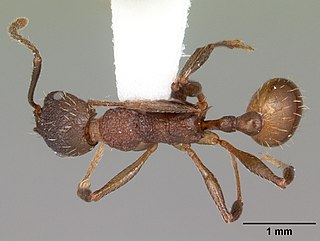Related Research Articles

Aphaenogaster is a genus of myrmicine ants. About 200 species have been described, including 18 fossil species. They occur worldwide except in South America south of Colombia, sub-Saharan Africa, and Antarctica.

Melissotarsus is a rare African genus of ants in the subfamily Myrmicinae. They are known from the Afrotropics and Malagasy regions, where their nests are located in living wood, built by tunneling through the wood under the bark. They are rarely seen outside of their nests, which may contribute to their perceived rarity. However, they are considered pest insects because of damage they can cause to trees, including economically important ones such as mangos and trees in the family Burseraceae, including Aucoumea klaineana, Dacryodes buettneri, and Dacryodes edulis.

Aphaenogaster amphioceanica is an extinct species of ant in the subfamily Myrmicinae known from a single possibly Miocene fossil found in amber on Hispaniola. At the time of description A. amphioceanica was one of two Aphaenogaster species known from the Caribbean islands.
Aphaenogaster praerelicta is an extinct species of ant in the subfamily Myrmicinae known from a solitary Late Oligocene to Early Miocene fossil found in Mexico. At the time of description A. praerelicta was one of three Aphaenogaster species known from Mexico.
Aphaenogaster avita is an extinct species of ant in the subfamily Myrmicinae known from a solitary early to middle Miocene fossil found in Japan. At the time of description A. praerelicta was one of twelve Aphaenogaster species to have been described from fossils and the only fossil species from Japan.
Malagidris is a Malagasy genus of ants in the subfamily Myrmicinae. Described in 2014, the genus contains six species.

Aphaenogaster sommerfeldti is an extinct species of ant in the subfamily Myrmicinae known from a group of Middle Eocene fossils found in Europe. A. sommerfeldti is one of three species in the ant genus Aphaenogaster to have been noted from fossils found in Baltic amber by William Morton Wheeler.

Aphaenogaster oligocenica is an extinct species of ant in the subfamily Myrmicinae known from a pair of Middle Eocene fossils found in Europe. A. oligocenica is one of three species in the ant genus Aphaenogaster to have been noted from fossils found in Baltic amber by William Morton Wheeler.

Aphaenogaster mersa is an extinct species of ant in the subfamily Myrmicinae known from a pair of Middle Eocene fossils found in Europe. A. mersa is one of three species in the ant genus Aphaenogaster to have been noted from fossils found in Baltic amber by William Morton Wheeler.

Novomessor ensifer is a species of ant endemic to Mexico. A member of the genus Novomessor in the subfamily Myrmicinae, it was first described by Swiss entomologist Auguste Forel in 1899. N. ensifer was originally a part of the genus Aphaenogaster until a recent phylogenetic study concluded that Novomessor was genetically distinct and should be separated. The ant is a medium-sized species, measuring 5.5 to 10 millimetres. The ant is ferruginous-colored in some certain parts of the body, and small workers (nanitics) in incipient colonies are noticeably different in color and body structure.

Novomessor albisetosus, also known as the desert harvester ant, is a species of ant found in the United States and Mexico. A member of the genus Novomessor in the subfamily Myrmicinae, it was first described by Austrian entomologist Gustav Mayr in 1886. It was originally placed in the genus Aphaenogaster, but a recent phylogenetic study concluded that it is genetically distinct and should be separated. It is a medium-sized species, measuring 6 to 8.5 millimeters and has a ferruginous body color. It can be distinguished from other Novomessor species by its shorter head and subparallel eyes.

Aphaenogaster uinta is a species of ant in the family Formicidae.

Aphaenogaster huachucana is a species of ant in the family Formicidae.

Aphaenogaster mariae is a species of ant in the family Formicidae.

Aphaenogaster patruelis is a species of ant in the family Formicidae.

Aphaenogaster picea is a species of ant in the family Formicidae.

Aphaenogaster texana is a species of ant in the family Formicidae.

Aphaenogaster fulva is a species of ant in the family Formicidae.